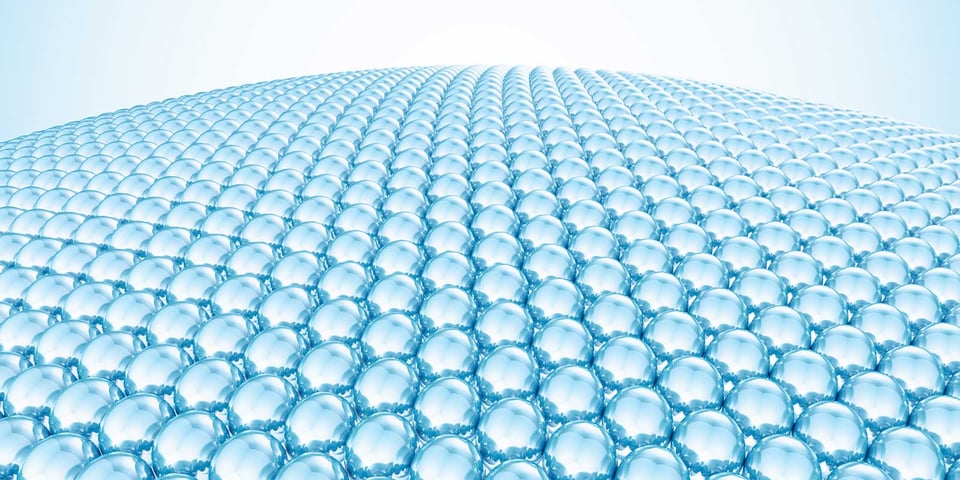
Nanoparticle lithography is a promising fabrication technique. Unlike other nanolithography techniques, such as laser-interference, deep-UV, electron- or ion-beam beam lithography, it has a potential to be up-scaled as a parallel process and the capability to be performed on complex substrate topologies such as curved surfaces. Initial investment and running costs are low and the technique can be applied with a large range of materials. Substrates can be non-conductive, semi-rigid, transparent or non-transparent whilst the nanoparticles themselves (commonly nanospheres) can be constituted from metals, inorganics or polymers.
Technologies which exploit nanostructures can be divided into those which require long range regular order (over tens of thousands of repeating units) and those which require only medium- and short-range order (hundreds to thousands of repeating units in a polycrystalline arrangement). As a self-assembly process, nanoparticle lithography can achieve the former (long-range crystalline order) with the aid of substrate features that direct the self-assembly process. However, for the many and diverse range of technologies which require only medium-range order or short-range order with a high fill factor then nanoparticle lithography is a prime candidate for the fabrication of proof-of-principle devices up to small volume device fabrication runs.
The nanosphere lithography process can be divided into two phases;
As a self-assembly process, the key to a successfully colloidal mask fabrication (phase 1) is to understand the specific properties of the nanomaterials being used in a given process. From this basis, one can begin to tune the self-assembly kinetics. For example, this may involve balancing particle-particle interactions with the behaviour or the wetting line and how it moves across the substrate’s surface.
Once a monolayer nanoparticle mask has been achieved on the substrate of choice, it can be converted into a myriad of different nanostructure topologies through the sequential application of secondary nanofabrication processes (phase 2). These include, but are not limited to: plasma etching, physical vapour deposition and solvent-based lift-off. Different combinations of these standard techniques can give rise to a remarkable range of nanostructures.
Nanoparticles can be made from a variety of different materials such as metals, metal oxides and polymers. Nanoparticles have very high surface energy due to high surface to volume ratio which can cause stability issues. Bare nanoparticles tend to rapidly stabilize themselves either by sorption of molecules from the surroundings or by lowering the surface area through coagulation and agglomeration. In lithography applications, the formation of a three-dimensional aggregate is undesirable. The tendency of a nanoparticle to coagulate can be controlled by modifying the surface layer. A variety of ligand molecules can be attached to a nanoparticles surface, the presence of which can prevent coagulation and dictate the particle’s solubility in a given spreading solvent. Nanoparticles in suspension are often somewhat complex objects, a bulk solid covered by a soft organic ligand shell. This understanding should be used to one’s advantage when specifiying a colloidal mask material.
Polystyrene and silica nanopspheres are most commonly used for colloidal mask formation. Nanospheres can be synthesised or purchased as monodisperse colloidal solutions with particle diameters varying from 5 nm up to tens of microns. As the average periodicity of the formed nanostructures is directly related to size distribution of the nanoparticles, the size of the nanofeatures can be controlled by simply changing the size of the nanospheres.
Anybody considering using nanosphere lithography as the fabrication process will quickly notice that the colloidal mask formation requires some thought. At first glance it might seem that getting nanoparticles on the solid substrate is just a matter of dipping your solid into nanoparticle solution. For some applications this might be true, but for nanosphere lithography it is hardly ever successful. To be able to form a uniform, monolayer of nanoparticles requires a more controlled fabrication technique.
To read more about fabrication methods for colloidal crystal mask, please download the short review titled “5 most common nanoparticle deposition methods”.
To see our nanoparticle coating solutions, go to the product page.
Prof. Federica Sebastiani uses QCM-D to study the binding affinity of serum proteins to mRNA-LNPs. Here she explains what LNP:s are.
Sign upp for the webinar to learn more about how QCM-D is used to study biomaterial-induced activation of the immune system
Nanoparticle thin films are gaining recognition and use in various products and applications including displays, sensors, and energy storage.
Read about how QSense QCM-D analysis is used to investigate the effect of airborne Palladium nanoparticles on human lung cells, endothelium and blood.
Nanomaterials have found their way into ordinary products such as foods, cosmetics, and sportswear. Why did ‘nano’ become so popular? And what risks are involved when getting exposed to these nanoengineered entities?
Here we list 10 methods that can be used to characterize the nanoparticle chemical composition.
